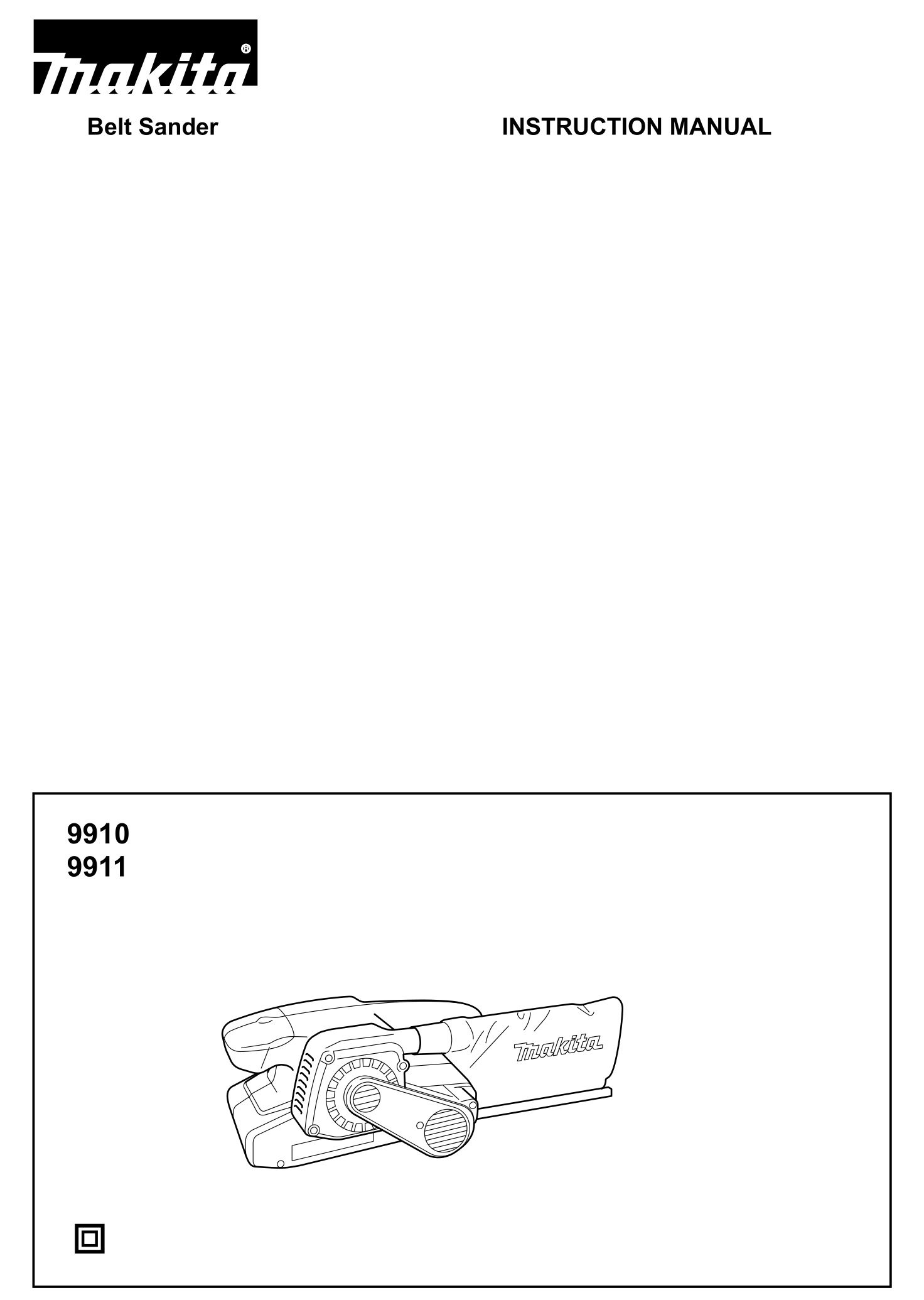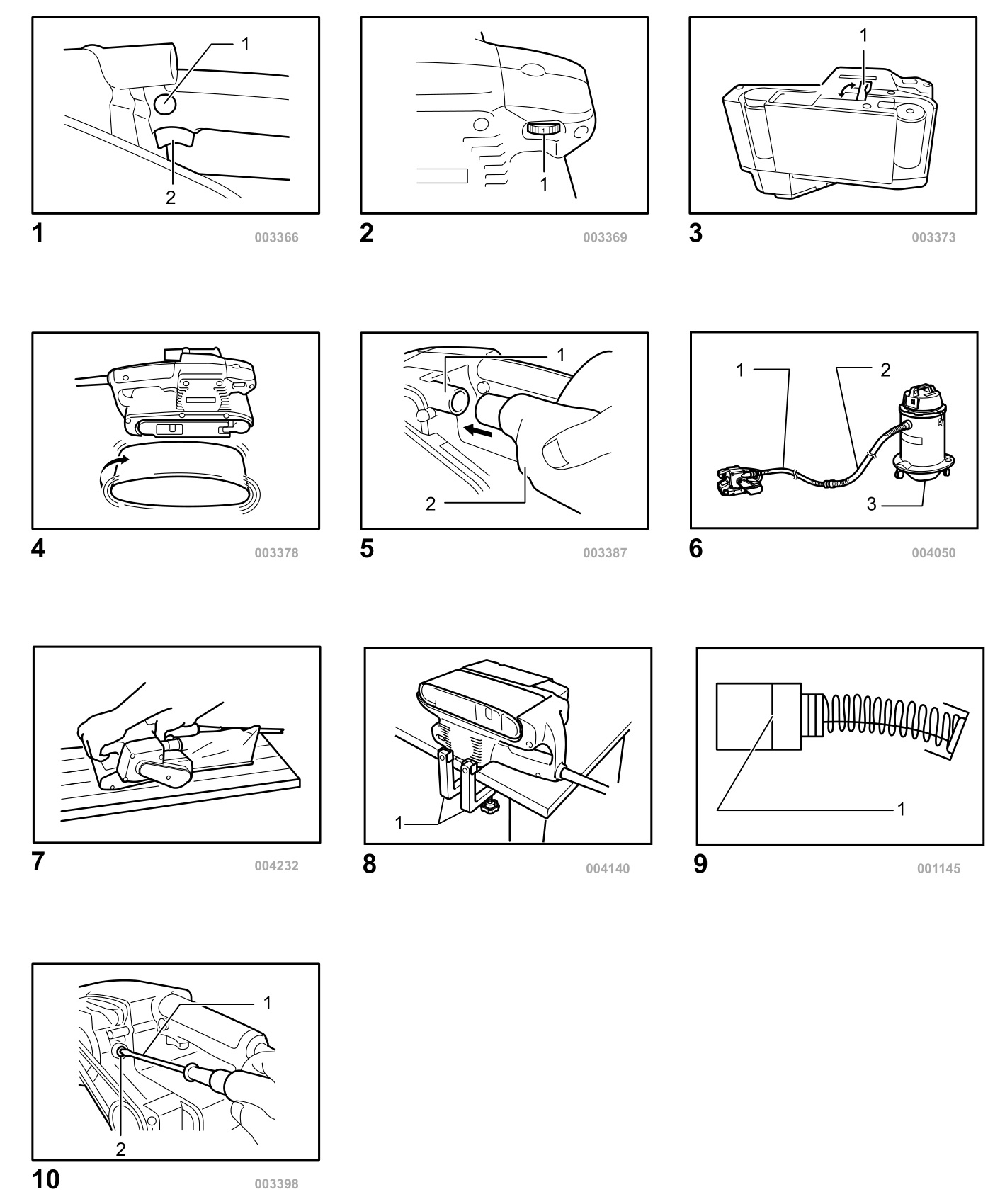Makita 9910 Belt Sander Instruction Manual
makita 9910 Belt Sander
Instruction Manual


Explanation of general view
1-1. Lock button
1-2. Switch trigger
2-1. Speed adjusting dial
3-1. Lever
5-1. Dust spout
5-2. Dust bag
6-1. Optional hose 28 mm in inner diameter
6-2. Hose of vacuum cleaner
6-3. Vacuum cleaner
8-1. Clamps
9-1. Limit mark
10-1. Screwdriver
10-2. Brush holder cap
SPECIFICATIONS
- Due to our continuing programme of research and development, the specifications herein are subject to change without notice.
- Specifications may differ from country to country.
- Weight according to EPTA-Procedure 01/2003
Intended use
The tool is intended for the sanding of large surface of wood, plastic and metal materials as well as painted surfaces.
Power supply
The tool should be connected only to a power supply of the same voltage as indicated on the nameplate, and can only be operated on single-phase AC supply. They are double-insulated in accordance with European Standard and can, therefore, also be used from sockets without earth wire.
For European countries only
Noise
The typical A-weighted noise level determined according to EN60745:
Sound pressure level (LpA) : 83 dB(A)
Sound power level (LWA) : 94 dB(A)
Uncertainty (K) : 3 dB(A)
Wear ear protection
Vibration
The vibration total value (tri-axial vector sum) determined according to EN60745:
Work mode : sanding metal plate
Vibration emission (ah) : 2.5 m/s2 or less
Uncertainty (K) : 1.5 m/s2
- The declared vibration emission value has been measured in accordance with the standard test method and may be used for comparing one tool with another.
- The declared vibration emission value may also be used in a preliminary assessment of exposure.
- The vibration emission during actual use of the power tool can differ from the declared emission value depending on the ways in which the tool is used.
- Be sure to identify safety measures to protect the operator that are based on an estimation of exposure in the actual conditions of use (taking account of all parts of the operating cycle such as the times when the tool is switched off and when it is running idle in addition to the trigger time).
EC Declaration of Conformity
We Makita Corporation as the responsible manufacturer declare that the following Makita machine(s):
Designation of Machine: Belt Sander
Model No./ Type: 9910,9911 are of series production and
Conforms to the following European Directives:
98/37/EC until 28th December 2009 and then with
2006/42/EC from 29th December 2009
And are manufactured in accordance with the following standards or standardised documents:
EN60745
The technical documentation is kept by our authorised representative in Europe who is:
Makita International Europe Ltd,
Michigan, Drive, Tongwell,
Milton Keynes, MK15 8JD, England
30th January 2009
Tomoyasu Kato
Director
Makita Corporation
3-11-8, Sumiyoshi-cho,
Anjo, Aichi, JAPAN
General Power Tool Safety Warnings
Save all warnings and instructions for future reference.
SPECIFIC SAFETY RULES
DO NOT let comfort or familiarity with product (gained from repeated use) replace strict adherence to belt sander safety rules. If you use this tool unsafely or incorrectly, you can suffer serious personal injury.
- Hold power tool by insulated gripping
surfaces, because the belt may contact its
own cord. Cutting a “live” wire may make
exposed metal parts of the power tool “live” and could give the operator an electric shock. - Ventilate your work area adequately when you perform sanding operations.
- Some material contains chemicals which may be toxic. Take caution to prevent dust inhalation and skin contact. Follow material supplier safety data.
- Always use the correct dust mask/respirator for the material and application you are working with.
- Always use safety glasses or goggles. Ordinary eye or sun glasses are NOT safety glasses.
- Hold the tool firmly with both hands.
- Make sure the belt is not contacting the workpiece before the switch is turned on.
- Keep hands away from rotating parts.
- Do not leave the tool running. Operate the tool only when hand-held.
- This tool has not been waterproofed, so do not use water on the workpiece surface.
SAVE THESE INSTRUCTIONS.
MISUSE or failure to follow the safety rules stated in this instruction manual may cause serious personal injury.
FUNCTIONAL DESCRIPTION
- Always be sure that the tool is switched off and unplugged before adjusting or checking function on the tool.
Switch action
Fig.1
- Before plugging in the tool, always check to see that the switch trigger actuates properly and returns to the “OFF” position when released.
To start the tool, simply pull the switch trigger. Release the switch trigger to stop.
For continuous operation, pull the switch trigger and then push in the lock button.
To stop the tool from the locked position, pull the switch trigger fully, and then release it.
Speed adjusting dial
For 9911 only
Fig.2
The belt speed can be infinitely adjusted between 75 m and 270 m per minute by turning the speed adjusting dial to a given number setting from 1 to 6. Higher speed is obtained when the dial is turned in the direction of number 6; lower speed is obtained when it is turned in the direction of number 1.
Select the proper speed for the workpiece to be sanded.
- If the tool is operated continuously at low speeds for a long time, the motor will get overloaded, resulting in tool malfunction.
- The speed adjusting dial can be turned only as far as 6 and back to 1. Do not force it past 6 or 1, or the speed adjusting function may no longer work.
ASSEMBLY
- Always be sure that the tool is switched off and unplugged before carrying out any work on the tool.
Installing or removing abrasive belt
Fig.3
Pull the lever all the way out and install the belt over the rollers, and then return the lever to the original position.
- When installing the belt, make sure that the direction of the arrow on the back of the belt corresponds to the one on the tool itself.
Fig.4
Adjusting belt tracking
- Steel plate
- Adjusting screw
Switch on the tool and make sure that the belt is aligned properly. If the edge of the belt extends beyond the edge of the steel plate or the edge of the belt retracts more than 8 mm away from the edge of the steel plate, use the adjusting screw to adjust the belt tracking.
Dust bag
Fig.5
Attach the dust bag onto the dust spout. The dust spout is tapered. When attaching the dust bag, push it onto the dust spout firmly as far as it will go to prevent it from coming off during operation.
When the dust bag is about half full, remove the dust bag from the tool and pull the fastener out. Empty the dust bag of its contents, tapping it lightly so as to remove particles adhering to the insides which might hamper further collection.
NOTE:
- If you connect a Makita vacuum cleaner to this tool, more efficient and cleaner operations can be performed.
Connecting to Makita vacuum cleaner
Fig.6
Cleaner sanding operations can be performed by connecting the belt sander to Makita vacuum cleaner. When connecting to Makita vacuum cleaner, an optional hose 28 mm in inner diameter is necessary.
OPERATION
Sanding operation
Fig.7
- The tool should not be in contact with the workpiece surface when you turn the tool on or off. Otherwise a poor sanding finish or damage of the belt may result.
Hold the tool firmly with both hands. Turn the tool on and wait until it attains full speed. Then gently place the tool on the workpiece surface. Keep the belt flush with the workpiece at all times and move the tool back and forth. Never force the tool. The weight of the tool applies adequate pressure. Excessive pressure may cause stalling, overheating of the motor, burning of the workpiece and possible kickback.
Clamps (optional accessory)
This machine can be operated in the inverted position. To do so, secure the machine to a stable workbench with two clamps.
Fig.8
MAINTENANCE
- Always be sure that the tool is switched off and unplugged before attempting to perform inspection or maintenance.
Replacing carbon brushes
Fig.9
Remove and check the carbon brushes regularly. Replace them when they are worn down to the limit mark. Keep the carbon brushes clean and free to slip in the holders. Both carbon brushes should be replaced at the same time. Use only identical carbon brushes. Use a screwdriver to remove the brush holder caps. Take out the worn carbon brushes, insert the new ones and secure the brush holder caps.
Fig.10
To maintain product SAFETY and RELIABILITY, repairs, any other maintenance or adjustment should be performed by Makita Authorized Service Centers, always using Makita replacement parts.
ACCESSORIES
- These accessories or attachments are recommended for use with your Makita tool specified in this manual. The use of any other accessories or attachments might present a risk of injury to persons. Only use accessory or attachment for its stated purpose.
If you need any assistance for more details regarding these accessories, ask your local Makita Service Center.
- Abrasive belts
- Dust bag
- Clamp
- Hose 28 mm in inner diameter
Makita Corporation Anjo, Aichi, Japan